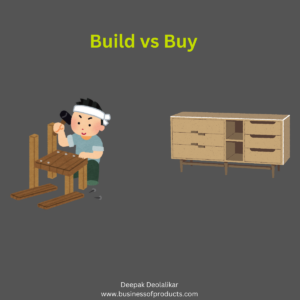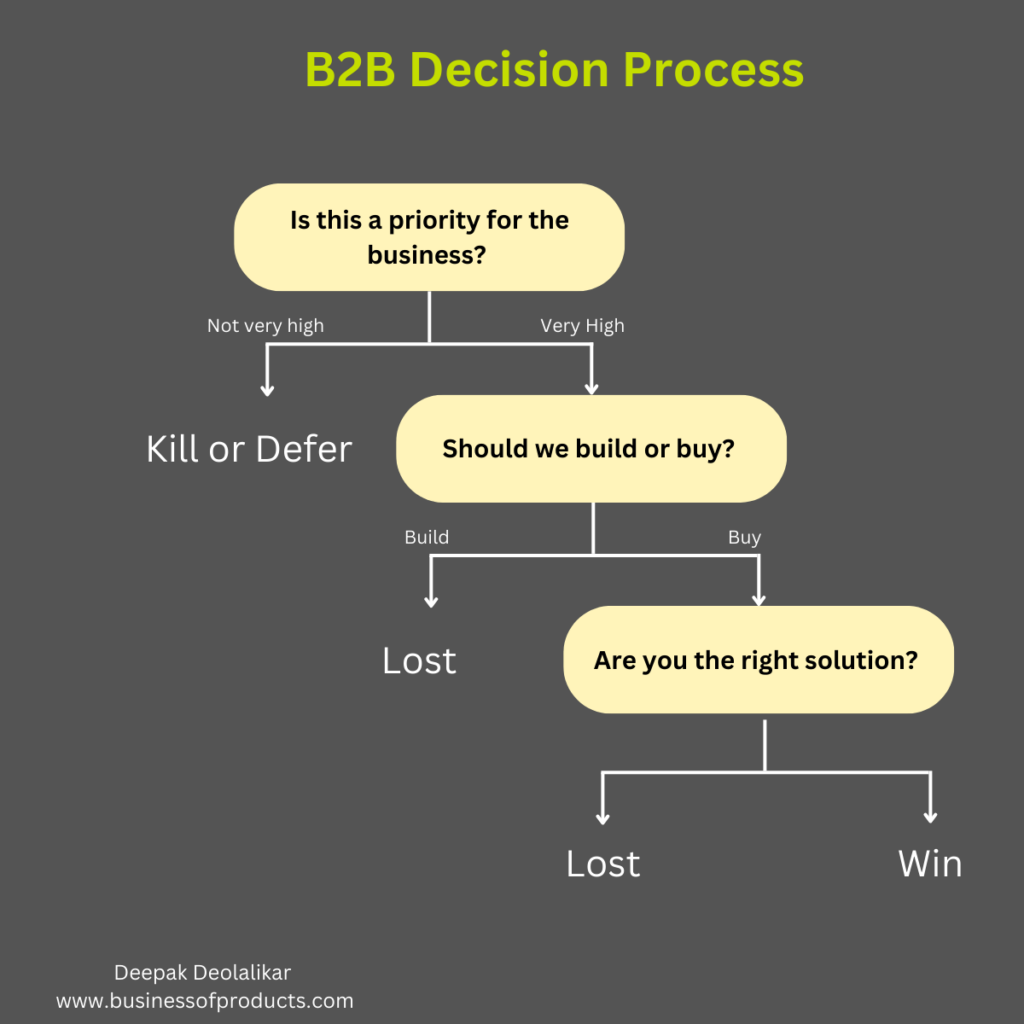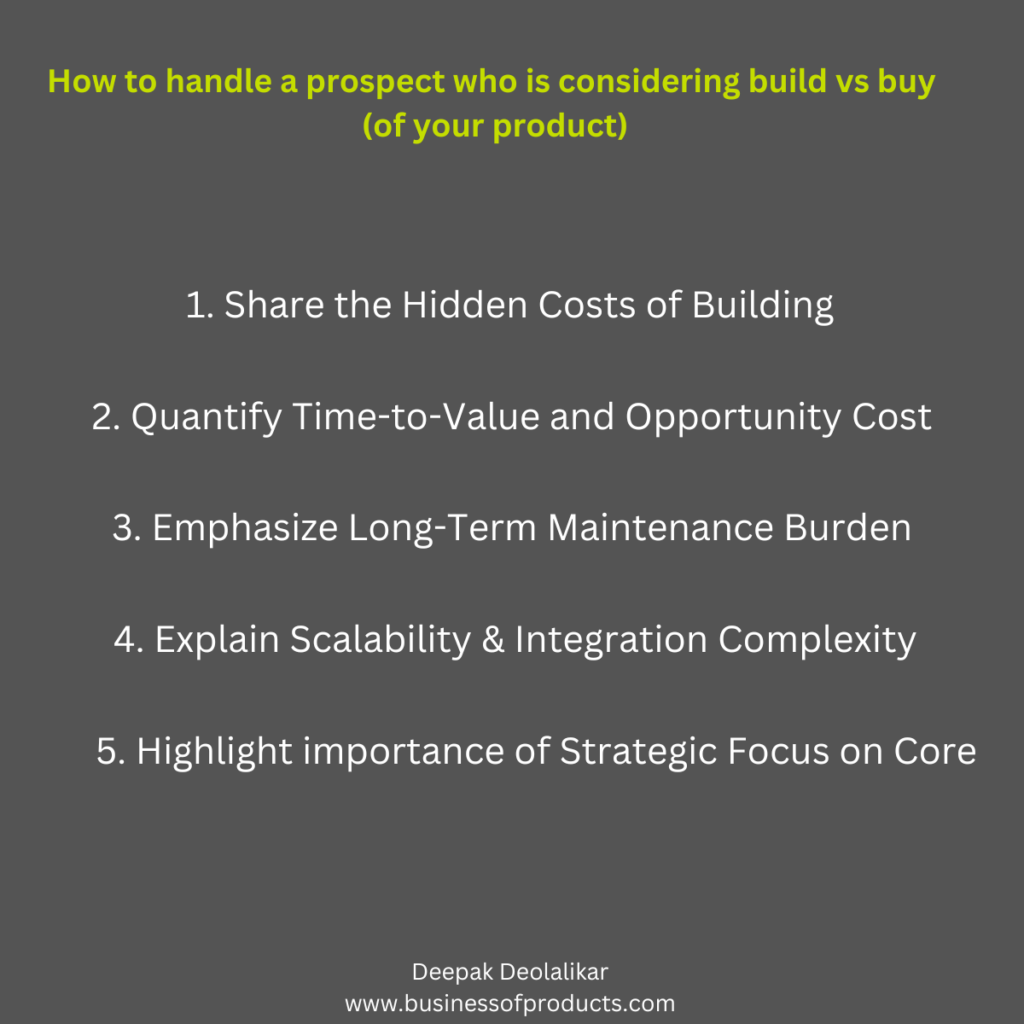Decision point # 2 - Should we build or buy ?

In a previous article, we discussed the 3 decision points that a B2B buyer goes through.

Once a prospect decides this problem is a priority, the next decision is to buy or build.
Decision Point #2 – Build vs. Buy
For many B2B companies, the question of build vs. buy arises when evaluating software solutions. Should they develop an in-house tool, or is purchasing a third-party solution the smarter move?
Of course, the decision to build or buy does not apply to all types of products. No one in their mind will want to build a CRM or email product on their own. But there are many elements that can be built in-house. In my previous company, we built the single sign on infrastructure which could easily have been bought commercially. Consider applications like invoicing, quoting, forecasting, notifications and messaging, in app tours, product metrics, reporting, dashboarding and telemetry etc.
And many times it is not just technical considerations that are at play. Once I was asked to rebuild the reporting infrastructure. The problem was severe and had to be solved to prevent churn. The requirements were complex and a full build would have taken at least a year, if not more. I suggested we buy the solution, and one of our partners had already built a very capable solution. There were two challenges. The first one was technical. The partner had built the product on an old framework and that was a no-no from the get go from the engineering team. I worked with the partner to come up with a plan to help them migrate to the new platform. Engineering was already circumspect. Add to that, the engineering team had a “built in house” culture. So already it was a high bar for me to sell the idea internally. The business teams were on board as this would help with retention.
The second challenge was a management one. The partner was based in a country where we had no operations. That meant managing a new set of admin, legal, HR, infrastructure issues.
In the end, we decided to build the reporting in house. In hindsight, I believe it was a good decision as we were able to create a modern functionality.
What can you do as a founder?
As a founder, you’ll often encounter prospects wrestling with this decision. What can you do to influence them?
The key is to help them navigate the trade-offs by focusing on cost, speed, expertise, scalability, and strategic priorities.
Here are five essential points to guide the conversation.

1. The Hidden Costs of Building
Many companies focus on the initial cost of development when considering building their own solution. But the real cost isn’t just in writing the first lines of code—it’s in the ongoing maintenance, security updates, compliance management, and scalability efforts.
A custom-built tool means:
Hiring or reallocating developers to build and maintain the software.
Addressing security vulnerabilities and ensuring compliance.
Managing bugs, infrastructure, and feature requests over time.
A third-party solution, on the other hand, typically offers predictable costs, dedicated support, and continuous improvements. The key question for prospects: Are you prepared for the total cost of ownership beyond the initial build?
2. Time-to-Value and Opportunity Cost
Building software takes time—often far longer than companies expect. In the meantime, they lose valuable opportunities to improve operations, engage customers, or outpace competitors.
Instead of spending months (or years) building a tool, buying a ready-made solution accelerates deployment and ROI. A good way to frame this is:
“Every month spent building is a month where your competitors move ahead. What’s the cost of delaying results?”
If the prospect is in a competitive market or needs a solution fast, buying is often the smarter move.
3. Internal Expertise & Long-Term Maintenance Burden
Even if a company has a talented engineering team, maintaining a homegrown solution requires ongoing effort. Over time, priorities shift, team members leave, and internal projects get deprioritized—leading to tech debt and outdated systems.
Ask them:
Do you have dedicated resources to maintain and improve this software long-term?
Will it be a priority in two years, or will it become a burden?
With a SaaS solution, they don’t have to worry about maintenance, feature updates, or keeping up with industry best practices. The provider takes care of that—allowing their team to focus on innovation.
4. Scalability & Integration Complexity
Custom-built software often starts as a simple solution but quickly becomes hard to scale. Integrating it with CRMs, analytics platforms, or other business-critical tools can also be a challenge.
A SaaS product, however, is designed for scalability and typically comes with API support and built-in integrations. This means:
Faster adoption across teams.
Seamless connectivity with existing tools.
No bottlenecks when scaling up.
If the prospect’s business is growing, scalability should be a key factor in their decision-making.
5. Strategic Focus: Core vs. Context
Perhaps the most important question in the build vs. buy debate is:
Is this software core to your business, or just a necessary function?
Companies should focus their engineering resources on their core value proposition—the unique innovation that differentiates them. If the software they need isn’t a key differentiator, it makes more sense to buy and free up internal resources for more strategic initiatives.
A good way to frame it:
“Do you want your best engineers working on this, or on the product that actually drives your business forward?”
Final Thought: Build or Buy? Helping Prospects Make the Right Call
The decision to build vs. buy isn’t always black and white. But as a founder, your role is to help prospects think through the true cost, time, expertise, scalability, and strategic impact of their choice.
Rather than pushing them toward your solution outright, guide them through the trade-offs. The best sales conversations don’t just sell—they help prospects make the best decision for their business.
Finally, if your prospect is finally leaning towards building it in house, then offer them help. Share your feature set, best practices, lessons learnt etc. Act like a trusted advisor for your prospect. Your prospect will appreciate you and you build your trust. More likely, when the time comes when they decide that building was a wrong choice and they should consider buying, you will be the first choice. May not now, maybe later. But it’s worth considering it.
Next Article
Are you the right solution

